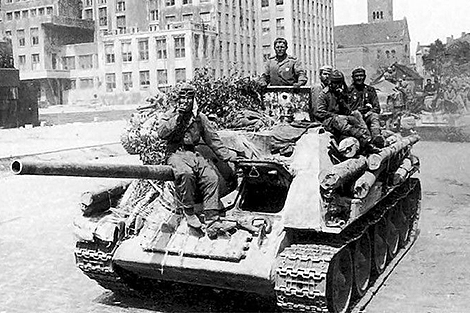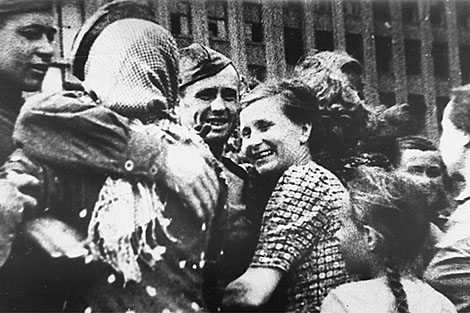Press releases
Symbol of courage and pride. Minsk celebrates the 50th anniversary of Hero City title

An archive photo
MINSK, 26 June (BelTA) – Fifty years ago, on 26 June 1974, the city of Minsk was awarded the honorary Hero City title, the Order of Lenin and the Gold Star medal, BelTA has learned.

"Minsk was occupied on 28 June 1941. From the first days, Minsk residents were actively involved in the fight against the aggressor," said Anatoly Krivorot, a leading researcher at the Institute of History of the National Academy of Sciences of Belarus. “Dozens of underground groups and organizations operated in the capital. Despite significant losses and persecution, they made a great contribution to the liberation of the city. They carried out sabotage operations, helped prisoners of war who ended up in the city in the first months of the war, and partisans," the historian said.
Many Minsk residents joined partisan units, the brigades Shturmovaya, People's Avengers named after V.T. Voronyansky, and many others.


"It is important to highlight one more point: on 16 July 1944, a rally and a partisan parade were held on the field of the former hippodrome. This event once again emphasized the significant contribution of Minsk residents to the victory in the Great Patriotic War. Minsk was first awarded the Order of Lenin, and then became a hero city," Anatoly Krivorot added.
The title has become a symbol of courage and pride of local residents. Having destroyed the city, the enemy did not break the will of the Soviet people. This topic has become the subject of scientific research. The historian recalled that in the spring of 2020, the National Academy of Sciences launched the All-Belarusian campaign "People's Chronicle of the Great Patriotic War: Let's Remember All". People from different regions of Belarus responded to this initiative and shared the stories of front-line soldiers, partisans, underground fighters. Several publications have already been published. "We learned very interesting, previously unknown facts about the Minsk underground," the historian said.
The significant losses suffered by the German fascist troops in the battles near Minsk at the beginning of the war affected the pace of their advance towards the Dnieper. The defenders held back large enemy forces for four days, which largely contributed to the disruption of Hitler's plan for a "lightning war".
During the occupation, the Minsk underground was concentrated around the Minsk railway junction. Here, several groups were set up already in July-August 1941. They merged into one later. They were created by party workers, university professors, doctors and military personnel. Until the end of 1941, according to incomplete data, more than 50 underground organizations operated in the city and the district and included more than 2,000 people.
In March - April 1942, the Nazis arrested a lot of underground resistance members. 279 patriots were executed, including 28 senior members of the resistance movement. However, despite the setbacks, resistance was gaining momentum. In 1942, there were already 100 underground resistance organizations and groups numbering 3,200 people. The Minsk underground committee of the BSSR Communist Party published a newspaper Zvyazda that was distributed in Minsk and in many other places and sent to partisans.
In September-October 1943, the occupiers dealt another heavy blow to the Minsk underground resistance movement when they jailed all senior members of the city government and hundreds of underground resistance members. But the resistance never stopped.
The assassination attempt on the Gauleiter of Belarus Wilhelm Kube on 22 September 1943 was one of the highlights of the resistance movement in Minsk. In total, 116 underground groups and organizations operated in the city during the occupation. They had 6,355 members: those were people from all walks of life, representatives of 25 ethnicities of the USSR, anti-fascists from foreign countries. There were more than 200 safe houses. Minsk underground resistance fighters carried out more than 1,500 combat operations. Many of them were awarded orders and medals.
From 28 June 1941 to 3 July 1944, the invaders set up several concentration camps in Minsk and the surrounding area (at the Storozhevsky cemetery, near the village of Drozdy, on Shirokaya Street, Stalag No. 352 Masyukovshchina), the Trostenets death camp, and the Minsk ghetto. The Trostenets camp was the largest Nazi extermination camp on the territory of the Soviet Union and the fourth largest in Europe following the infamous Auschwitz, Majdanek, and Treblinka.



Minsk was liberated from the Nazi invaders during Operation Bagration. Tank forces played a crucial role in the offensive. The occupation forces were driven out of Minsk late in the evening of 3 July 1944. In honor of this, a salute was given in Moscow with 24 artillery salvoes from 324 guns. Some 52 units and formations were given the honorary title “Minsk”.
The city was left in ruins: only 19 out of 332 enterprises survived. The Nazis destroyed 79 secondary and vocational schools, 80% of the housing stock. An art gallery, the philharmonic society, the Academy of Sciences, a library, Belarusian State University, the opera and ballet theater, and many schools and museums were plundered. The capital was rebuilt by 1950, although the rebuilding effort continued for many more years.
In 1985, the Minsk-Hero City Stele was unveiled. A new building for the State Museum of the Great Patriotic War History was commissioned nearby later on. The stele is 45 m high. The obelisk is topped with the Gold Star medal. An engraved text about conferring the Hero City title to Minsk is at the bottom.







 print version
print version make home page
make home page add to bookmarks
add to bookmarks

